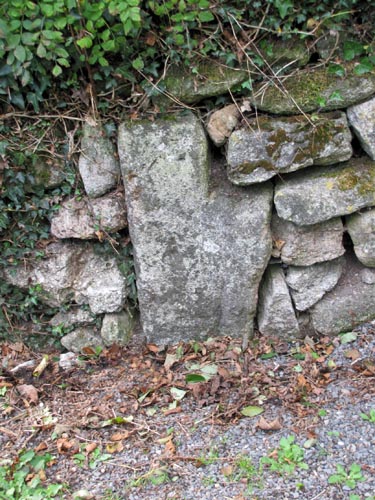 Location:
In the roadside wall, to the LHS of the gateway entrance to Stannon Lodge,
opposite the church. Location:
In the roadside wall, to the LHS of the gateway entrance to Stannon Lodge,
opposite the church.
O/S Grid Ref: SX/65169/79226 Longitude/Latitude (Degrees+/-): -3.90642/50.59714 Map location: Click here to view map. Purpose: Waymarker Size: 2 feet 1 inch (0.63 metres) tall. 13 inches (0.33 metres) across the shaft and the remaining piece of arm. The shaft is 7½ inches (0.19 metres) wide at the head and 10 inches (0.26 metres) wide, below the arms. Information: This stone, currently built into the roadside wall, provides more than a little mystery. It is quite possible, but not certain, that it is the remains of one of two crosses that could once have stood nearby. It is not easy now, when looking at the stone, to envisage how it would have looked when first erected in position. This cross is often referred to as ‘Maggie’ (St Margaret’s) Cross but, as will be seen below, this may or may not be the correct name for this interesting stone. The first possibility is that it is the stone referred to as ‘a stone called Merry Pit’. William Crossing wrote that, in July 1831, Mr Bray reported a fallen cross on Merripit Hill lying near a circular pit, close to the road on the left as he was going to Postbridge. He also wrote that Jonas Coaker, the famous Dartmoor poet, could recall this stone being removed to Postbridge and used as a post for the toll-gate. Jonas Coaker also recalled the presence of a cross at the junction of the Stannon track with the main trans-moor track from Exeter to Tavistock. It is this cross that he referred to as the ‘Maggie Cross’. The ancient trans-moor track, which preceded the current road, boasted two or three other crosses in the section between Moretonhampstead and Two Bridges. The Beetor and Leeper crosses were set on the line of this track and there is the possibility that Bennet’s Cross also served to mark this route. This track went out of use when the turnpike road, the forerunner of the current B3212, was built. It is not known what happened to this cross when it was removed from its position at the side of the track. Neither is it known what happened to the stone that was used for the post at the toll-gate, when the toll-house was demolished at the end of the 19th century. However, it does seem likely that one of these stones has turned up, where we see it today, in the roadside wall of Stannon Lodge.
Situated on the lower south-west slopes of Stannon Tor, is the isolated building named the Scotch Sheepfold. This is a large and well-built shelter with substantial vertical stones incorporated within the outer walls to reinforce the horizontal layers of smaller stones. Inside the sheepfold, another row of vertical stones runs parallel to the external wall, which indicates either the presence of an internal wall or that they were used as supports for a lean-to shelter at some point. In recent years, the sheepfold has undergone extensive repairs to its walls, to make good the damage caused by moorland animals.
|